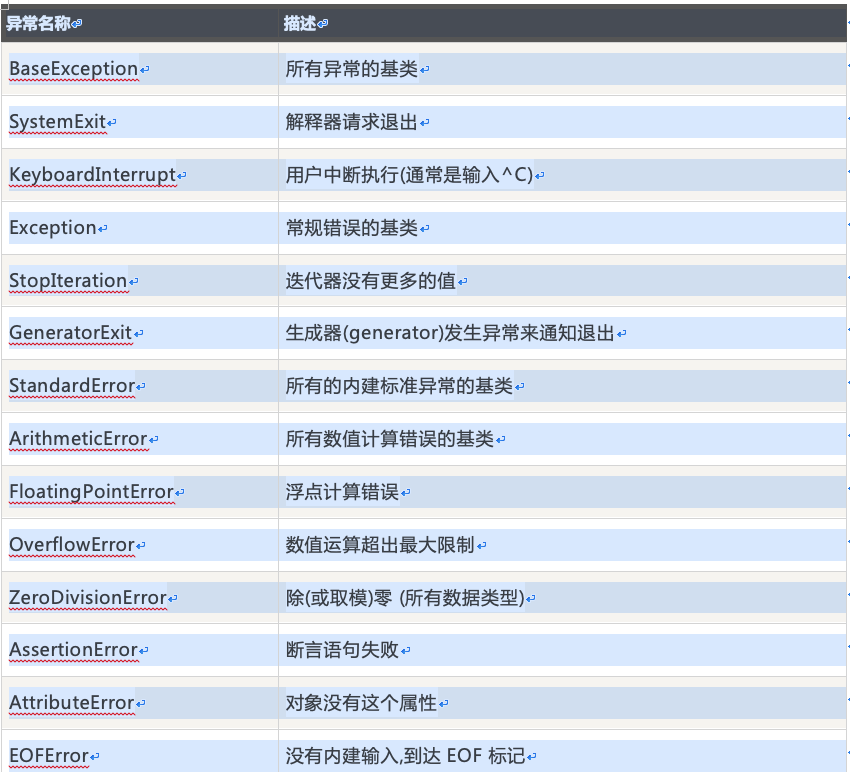在Python编程中不可避免的会出现错误,在调试阶段出现语法之类的错误时,Pycharm会在Debug窗口提示错误,但是程序在运行时由于内部隐含的问题而引起错误,会导致程序终止执行。比如以下例程中,使用urllib库打开URL时由于网络问题而发生了错误:
import urllib.request
req = urllib.request.urlopen('http://www.baidu.com')
print(req.read())
Traceback (most recent call last):
……
TimeoutError: [WinError 10060] A connection attempt failed because the connected party did not properly respond after a period of time, or established connection failed because connected host has failed to respond
在Python中出现解释器无法正常处理的程序时会引发异常。如果要避免程序在异常发生时结束运行,那么通常使用异常处理语句捕捉异常,再通过其他的逻辑代码让程序继续运行。异常处理语句为try/except,它的基本语法结构如下:
try:
< 语句 > # 运行代码
except [(Error1, Error2, ...)[as e]]:
< 语句 > # 如果在try中引发了'Error1'异常
except [(Error3, Error4, ...)[as e]]:
< 语句 > # 如果在try中引发了'Error3'异常
except:
< 语句 > # 如果在try中引发了其他异常
当Python 解释器在执行 try 中的代码时出现异常,Python 解释器会依次判断该异常对象是否是 except 块后的异常类或其子类的实例,根据该异常的类型寻找能处理该异常对象的 except 块,如果找到合适的 except 块,则把该异常对象交给该 except 块处理。如果 Python 解释器找不到捕获异常的 except 块,则程序运行终止,Python 解释器也将退出。
从 try except 的基本语法格式可以看出,try 块仅有一个,但 except 代码块可以有多个,这是为了针对不同的异常类型提供不同的异常处理方式,比如以下例程中,分别定义了浮点计算错误FloatingPointError异常和输入/输出操作失败IOError异常:
try:
import urllib.request
req = urllib.request.urlopen('http://www.baidu.com')
print(req.read())
except FloatingPointError:
print("Capture FloatingPointError")
except IOError:
print("Capture IOError")
except Exception:
print("Capture Error")
except:
print("Capture Error")
以上程序针对 FloatingPointError、IOError类型的异常,提供了专门的异常处理逻辑。该程序运行时的异常处理逻辑可能有如下几种情形:
- 如果在运行该程序时出现浮点计算错误,Python 将调用 FloatingPointError 对应的 except 块处理该异常。电动叉车
- 如果在运行该程序时出现输入/输出操作失败,Python 将调用IOError对应的 except 块处理该异常。此处解释器会执行IOError的异常处理。
- 如果在程序运行时出现其他异常,Python 可以调用 Exception 对应的 except 块处理该异常。当然except后面也可以不指定任何异常类。
在语法中的[]内为可选内容,于是可以有以下几种形式:
- except 后不指定具体的异常名称,表示要捕获所有类型的异常。
try:
< 语句 > # 运行代码
except:
< 语句 > # 如果在try中引发了其他异常
- except 后指定具体的异常名称,表示捕获指定类型的异常。比如 Error1、Error2、Error3、Error4分别表示各自的 except 块可以处理异常的具体类型。
try:
<语句> # 运行代码
except Error1:
<语句> # 如果在try中引发了'Error1'异常
- [as e] 表示将异常类型赋值给变量 e,以方于在 except 块中调用异常类型。所有的异常对象都包含了如下几个常用属性和方法:
• args:该属性返回异常的错误编号和描述字符串。
• errno:该属性返回异常的错误编号。
• strerror:该属性返回异常的描述字符串。
• with_traceback():通过该方法可处理异常的传播轨迹信息。
try:
import urllib.request
req = urllib.request.urlopen('http://www.baidu.com')
print(req.read())
except FloatingPointError:
print("Capture FloatingPointError")
except IOError as e:
print("Capture IOError")
print(e.args) # 访问异常的错误编号和详细信息
print(e.errno) # 访问异常的错误编号
print(e.strerror) # 访问异常的详细信息
except:
print("Capture Error")
(TimeoutError(10060, 'A connection attempt failed because the connected party did not properly respond after a period of time, or established connection failed because connected host has failed to respond', None, 10060, None),)
None
None
如果要查看更详细的异常信息,可以导入traceback模块,使用print_exc()打印异常信息。print_exc()还可以接受file参数直接写入到一个文件。比如:
traceback.print_exc(file=open('except.txt', 'w+')) # 写入到except.txt文件去
以下为Python部分标准异常类:

·····························